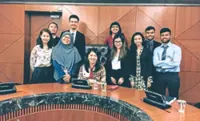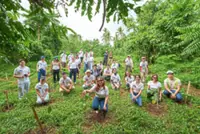IN 2019 alone, Malaysia received over 26 million tourists, generating some RM86bil in revenue.
According to the Ministry of Tourism, Arts and Culture Malaysia (Motac), our tourism industry directly employs over 660,000 people in Malaysia, representing about 9% of the nation’s workforce.
Fast forward to the current landscape, sustainability is an increasingly vital aspect of our daily lives and of businesses’ operations, drawing focus on carbon-intensive industries like aviation, accommodation and food and beverage (F&B).
Encouragingly, there has been an uptake of “decarbonisation” practices by public and private players of the sector to transform the travel industry – not only reduce its carbon footprint but also contribute to the growth of local economies.
Direct and indirect impact
The travel industry, in particular, has long been associated with high levels of greenhouse gas (GHG) emissions and waste generation, not to mention the vast amounts of waste, including plastic bottles, food waste and other single-use items generated from tourism activities.
While it’s impossible to provide an exact figure for total waste generated by the tourism industry in Malaysia, available data from aggregate sources of data suggests significant contributions, particularly in plastic waste generation.
On the other hand, aviation accounts for around 2.5% of global CO2 emissions, according to the International Energy Agency (IEA) and the Intergovernmental Panel on Climate Change (IPCC).
Adding to that, based on 2018 data from the IEA, our transport sector contributes to 36.4% of the total final energy demand (23,555 ktoe), making the sector the largest energy user in Malaysia.
While the 2.5% figure mainly refers to direct CO2 emissions from aircrafts, aviation’s overall impact on climate is estimated to be higher due to other factors like:
> Contrails and cirrus clouds: These high-altitude clouds trap heat, amplifying the warming effect.
> Nitrogen oxides: These emissions contribute to ozone formation, which also has a warming effect.
> Water vapour: At high altitudes, water vapour from aircraft emissions can contribute to warming.
Experts opine that the common thread tying the challenges of sustainable aviation and tourism lies in overcoming entrenched systems driven by fossil fuels and unsustainable practices.
Both industries require advancements in technology, infrastructure and regulations, while grappling with high costs and changing consumer behaviour.
Sustainable measures
To tackle these complexities, Malaysia Association of Tour and Travel Agents (Matta) president Nigel Wong says: “
We have recently started our own sustainable tourism initiative which is known right now as the Green Circle Project.
Basically, it’s based on the economic benefits of sustainable tourism and not just about going green.
“It consists of three components with the first being awareness and education. So,
Matta will be coming up with a set of guidelines and list of best practices, using the UN SDGs as a base.
This will be done in collaboration with many of our partners who are both local and international bodies.”
He notes that there are already established practices for the industry.
“The guidelines we’re developing will help our members become more sustainable through the packages they sell and the products they provide customers.
This [approach] looks through the whole supply chain to ensure that they can create green products all the way down the supply chain,” adds Wong.
Wong emphasises the importance of public involvement, citing how the initiative also aims to educate Malaysians on the “green assets” that we have and help them be more sustainable by informing them on their purchasing decisions and the places they visit.
“Running parallel, the second component is where we will prepare the industry for initiatives and incentives the government is offering as part of its carbon neutral goals.
“We know there are many programmes being designed for businesses going green and we want to ensure that our members can get the opportunity to join these incentives and programmes when it’s announced by the government,” he says.
Adding to that, Wong says that the Green Circle Project also has a corporate social responsibility (CSR) component, which started last year in World Travel Market 2023 at ExCeL London, with partners Malaysia Airlines and Tourism Malaysia.“We’re looking at supporting specific projects across Malaysia, starting with the Royal Belum Rainforest in Perak,” he states.
By working with British wildlife artist, Rachel Gray, whose paintings and merchandise created will be auctioned off using NFTs (non-fungible tokens). Proceeds will then go back to supporting the local community in the project area.
Matta will also involve its members in promotional and marketing activities for these tourism products and even helping communities in the business ventures.
Getting consumers on board
Similarly, airlines are investing in more fuel-efficient aircraft, optimising flight routes, and implementing carbon offset programs to mitigate emissions.
Last June, Malaysia Airlines became the first airline in Malaysia to launch a voluntary carbon offset programme.
In a statement, the company said that the initiative enables individuals and corporate customers to calculate, understand and offset the carbon emissions associated with their flights by supporting verified carbon offsetting projects when booking flights through the airline’s website.
Through the carbon offset programme, Malaysia Airlines’ customers will be provided with visibility into the carbon emissions generated by their flights during the booking process and are provided with the option to offset their emissions from the flight by supporting high-quality, certified carbon projects.
The funds paid to address the traveller’s carbon emissions will be used to support projects that reduce, capture, or avoid GHG emissions in an amount equivalent to that of the calculated carbon footprint of the journey.
Other methods of sustainable transportation such as public transit or cycling can further reduce the industry’s environmental impact if developed in tandem. Alongside the aviation industry, hotels and accommodations can focus on energy-efficient operations, waste reduction, and responsible sourcing of materials.
While the Covid-19 pandemic has undoubtedly affected the tourism industry’s immediate contribution to Malaysia’s gross domestic product (GDP), it is crucial to view this setback as an opportunity for transformation and sustainable growth.








